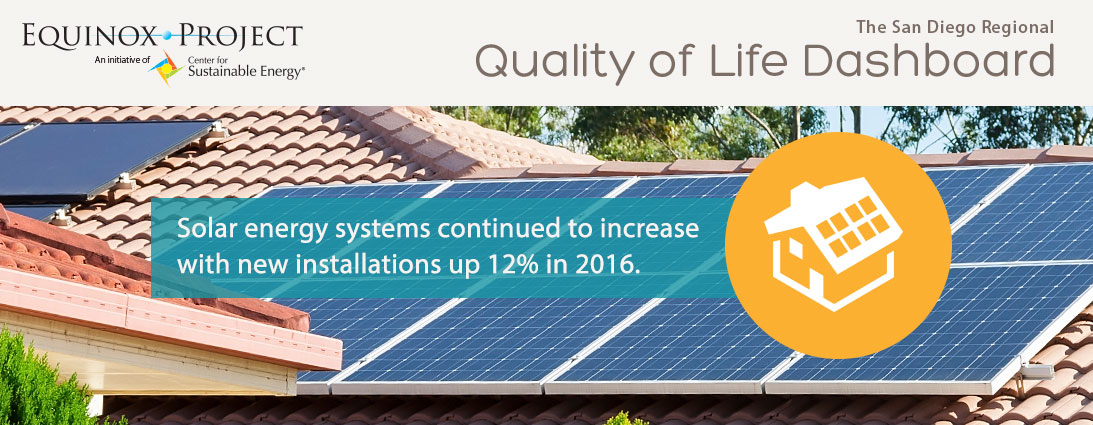

The Center for Sustainable Energy’s Equinox Project has released the 2017 San Diego Regional Quality of Life Dashboard, which assesses the top economic and environmental indicators to gauge the region’s progress toward sustainability. This year the dashboard is available for the first time in an online, interactive format at SDQualityofLife.org.
“This next generation of the dashboard will allow people to easily find up-to-date and visually engaging sustainability trends at the tap of a screen or click of a mouse,” said CSE President and Executive Director Len Hering, RADM, USN (ret.). “Decision-makers, community leaders, businesses and residents now can use the dashboard when they need it, and the new online platform allows us to update data as soon as it becomes available to better track changes throughout the year.”
Compared to last year, the eighth annual report shows six indicators that have improved, including climate action, electrified transportation, employment, renewable energy, residential electricity and water use, while six indicators showed regression, specifically landfill waste disposal, beach water quality, housing affordability, traffic, entrepreneurship and air quality. Among all 15 indicators, six are up, six are down and three remain neutral: park access, transportation choices and cross-border metrics.
“The Quality of Life Dashboard impacts our region by measuring and benchmarking important environmental and economic issues,” said Cody Hooven, the city of San Diego’s chief sustainability officer. “Only through measurement will issues improve. The dashboard not only gauges where we are but offers solutions to help us get where we need to go.”
Dashboard improving indicators
- Economy: The local unemployment rate (4.4%) in quarter four of 2016 remained lower than the state average (5.1%) and the national average (4.5%). In 2016, there we more than 248,000 government jobs while professional and business services was the largest private employment area with more than 234,000 jobs. The greatest rate of job growth during 2016 was in real estate (5.4%) and construction (4.5%). A highlight is that there are more than 800 clean energy technology companies in the region.
- Energy: Solar energy systems continue to increase with new installations up by 12%, totaling nearly 30,000 new installations in 2016. Renewable energy as a percentage of San Diego Gas & Electric sales increased from 35% in 2015 to 43% in 2016. Residential electricity consumption also is improving with the average annual residential electricity usage decreasing by 3% from 2015 to 2016.
- Water Use: The San Diego region continued to respond well to emergency drought regulations, with customers taking extraordinary measures to curtail water consumption. In 2016, county residential daily water use per capita decreased by nearly 15% from 96 gallons in 2015 to 82 gallons in 2016. The year recorded the lowest residential water use in at least 17 years assisted by a good rainfall year. The estimated average for municipal and industrial water use also decreased.
- Transportation: Sales of new electric vehicles (EVs) continued to rise in the San Diego region increasing by almost 9% in 2016. The number of public EV charging stations countywide remains modest at about one station per 10,000 residents, except for the city of Del Mar where there are four times the number of EVs per capita than any other area in San Diego and the highest ratio of public charging sites at 14 per 10,000 residents. However, traffic continues to bog down San Diego area commuters with the estimated average hours a year stuck in traffic increasing by 9% in 2016 to a total of 18 hours a year. Compared to other regions of California, San Diego continues to have a low rate of bicycle and public transit commuters at .6% and 3.5% of the workforce respectively.
- Climate Action: Cities in the region showed considerable movement with the city of Del Mar adopting its own climate action plan (CAP) in 2016 and Imperial Beach taking the first steps in developing a CAP in early 2017. Nine jurisdictions in San Diego County now have CAPs in place, six jurisdictions are developing, while four jurisdictions are without a CAP.
Areas needing improvement:
- Landfill Waste: San Diegans threw away almost 4% more landfill trash in 2015, the most recent data year, for a total of about 5.5 pounds of trash per day per person. Unfortunately, the region continues to dispose of more waste per capita than the state average and many of the state’s major urban counties. Del Mar had the most daily waster per capita at 14.3 pounds per day, with Imperial Beach being the lowest at 3.3 pounds per day.
- Beach Water Quality: The county’s total number of beach closures and water quality advisories in 2016 increased by nearly 14% from 81 beach-mile days in 2015 to 92 beach-mile days, largely due an 11-day closure of East Mission Bay. Areas around Mission Bay and Imperial Beach remain the hotspots for advisories and closures.
- Air Quality: The number of unhealthy air days increased slightly in the San Diego region from 41 days in 2015 to 42 days in 2016, the latest data year.
- Housing: Affordable housing continues to decrease with the median price for a single-family house in San Diego County at $568,000, an increase of 7% in 2016, considerably higher than the statewide average increase of less than 4%. The region’s housing affordability index remained around 26%, with little change from 2015, but is still about 5% lower than the state average, meaning fewer people can afford buying a home.
San Diego leaders in a wide variety of policy areas use the dashboard to help understand broad regional trends. The dashboard is a nonpartisan report card that tracks and grades quality of life indicators in 15 categories from data supplied by over 30 sources to evaluate livability in the region. This is the eighth edition of the dashboard since the report’s inception in 2010.
Local and national data sources for the dashboard include the San Diego County Water Authority, Bureau of Labor Statistics, California Public Utilities Commission, SANDAG, U.S. Department of Transportation and U.S. Census Bureau.
For the complete report, including charts and graphs, visit SDQualityofLife.org.
